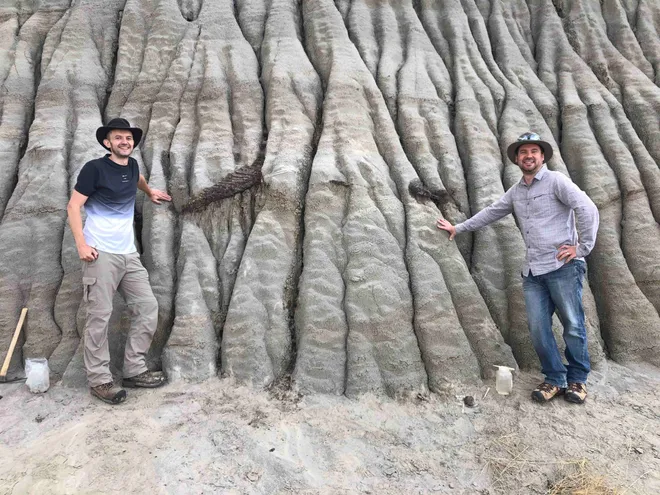ALBERTA-Fossil bits have been discovered jutting out from a cliff in Canada in 2021 that could be attached to a rare complete dinosaur skeleton, with complete fossilized skin.
Teri Kaskie, a volunteer field scout noticed a strange protrusion on a hillside in Dinosaur Provincial Park in Alberta and Reading University's paleontologist-ecologist Brian Pickles, who led the research, and identified the fragments as a hadrosaur.
With excitement, Pickles said that based on the physical traits of the fragments such as small of the tail and foot, he claimed that the fossil is most likely to be juvenile.
The herbivorous, duck-billed hadrosaurs were common during the late Cretaceous era, prospering between 75 and 65 million years ago. The particular hadrosaurs appear to be only around 4 meters (13 feet) in length whereas adults can reach 10 meters.

The Latest Fossil Uniqueness
Currently, only its tail and right hind foot are in view, giving the scientist a look at its intact fossilized skin. Together, those parts are posed in a way that claims the dinosaur's entire skeleton lies intact within its ancient encasing. Paleontologist from Royal Tyrrell Museum of Paleontology, Caleb Brown explained the hadrosaur fossils are relatively common in this part of the world but the other thing that makes their find unique is the fact that large areas of the exposed skeleton are covered in fossilized skin.
Brown added that the skin was preserved within the rock making it unique, giving them the further insight of what the hadrosaur looked like.
Pickles mentioned that the skin must have been covered up quickly upon its death 76 million years ago, he told USA Today. The paleontologists added that if they are lucky enough the dinosaur's internal organs might be well-preserved as well.

Other Discoveries
The paleontologists said that the remaining work will take months of painstaking to carve out the block of stone containing the fossils while also protecting the bits that are already freed from the stone.
The stone will then go to the Royal Tyrrell Museum of Paleontology, where the scientists will work carefully to expose the rest of the fossilized remains. This process could take years, with any luck the researcher will find an intact skull to tell them which species of hadrosaur it is.
According to Pickles, the adult duck-billed dinosaurs are well represented in paleontology, compared to the younger animals that are far less common.
That means the findings can help other researchers to understand how the hadrosaurs grew and developed.
The hadrosaurs get their duck-billed nickname from their broad and flat beak which grew from the front of their skull. This physique was ideal for snapping off tree leaves and twigs. At the back of their mouth lies hundreds to thousands of teeth that are suited for efficiently grinding the leaves-vegetation- before it was swallowed. According to Fossilera, a hypothesis attributes the multiple teeth as a reason for hadrosaur success in the Cretacous. This claim is based on sauropods being dependent on gastroliths to grind their food. However, there are several questions as to whether the gastroliths were utilized by sauropods.
RELATED ARTICLE : Dinosaurs Adapted to Cold Well Enabling Them to Survive the Triassic-Jurassic Extinction That Killed Most Terrestrial Specie
Check out more news and information on Dinosaurs in Science Times.
© 2025 ScienceTimes.com All rights reserved. Do not reproduce without permission. The window to the world of Science Times.









